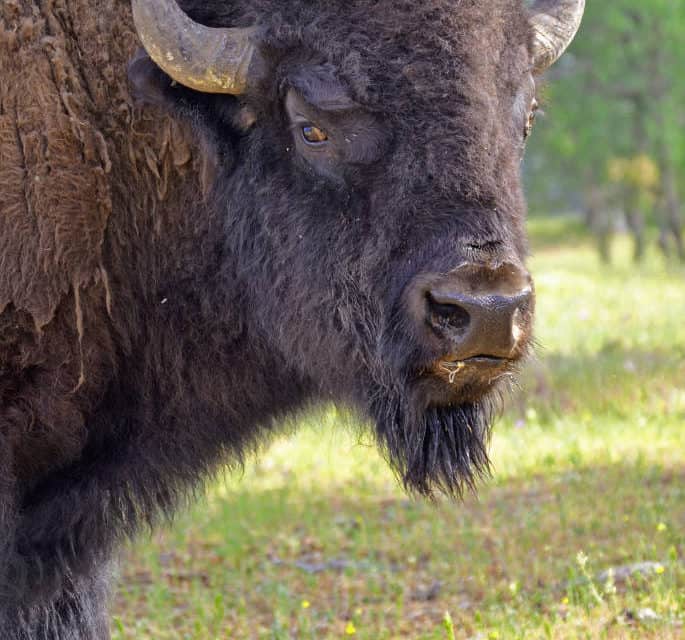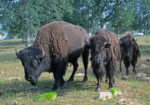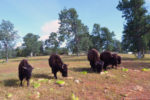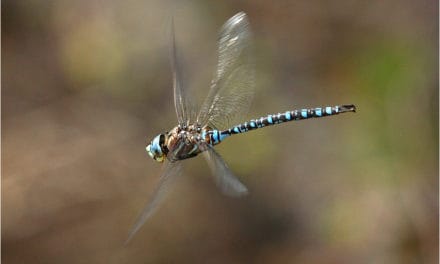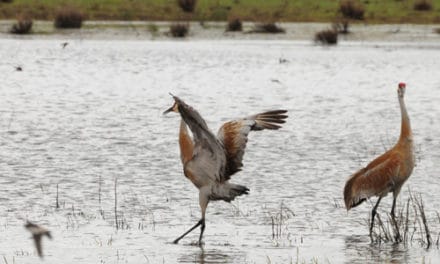By Dave Bartle
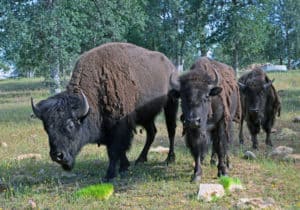
My first memory of buffalo is from the movie How The West Was Won in 1962, I was five years old. The scene where the buffalo stampeded the railroad workers camp was exciting and frightening at the same time. Now I am in a field in Igo, California, a ranch of 120 acres of rolling hills dotted with oak, pine and manzanita. I am about to experience firsthand my own personal buffalo stampede. Luckily, in this case, there are only seven buffalo and they are heading for their morning feeding of barley sprouts.
We drive into a fenced field in a Gator ATV as the buffalo run alongside of us a short distance away, stopping when we stop 100 feet from us. I like to call them to their meal with a bugle, ‘Burmmpppphhhhhh, barummp,’ goes the bugle, and here come the buffalo as their meal is tossed out to them. It is so cool to be standing in the open. A mere 20 feet from a full-grown buffalo bull. Close up you can see the shaggy fur sloughing off as they lose their winter coat heading into another hot Northern California summer. The herd’s owner Steve Rosenburg advises, “If you see one of them put their head down and their tail goes up, stop what you are doing, it means they are about to charge.” Well, pretty cool maybe, as I hear the How the West Was Won theme song in my head and remember the destruction wrought by the stampede in the movie.
Rosenberg has been raising buffalo in western Shasta County at his Rancho Igo No More for several years now. He got the idea when he was building his pond and it was suggested that with all the land he had he should raise buffalo. After researching the idea, he decided why not and contacted another local buffalo rancher who was selling some of his herd at the time.
With the price of hay being what it is, Rosenburg has switched to feeding the buffalo barley sprouts that he incubates himself. He brought the incubator in from Oregon and buys barley seeds two tons at a time to feed his herd. This will last seven buffalo about four months. It takes six days to incubate one row of bisquits. Each bisquit produces about 15 pounds of sprouts, enough feed for one full-grown buffalo per day. “It is amazing how much better the flavor of the meat is compared to just feeding them hay,” Rosenburg boasts. “Plus there are no growth hormones, steroids, or antibiotics.”
The buffalo have finished their meal and they don’t seem to like our closeness and have started to drift away. “They got out once,” Rosenburg remarks and proceeds to tell me about the great Igo Buffalo Stampede. They remained at large near the Veteran’s Cemetery for three or four days until a helicopter was called in to chase the herd into a nearby pen with a chute where they were finally loaded back into a trailer and taken home. Imagine buffalo running free in Western Shasta County even if it is only for a few days. Cue theme song.
To find out more about the Igo Buffalo herd or to try a taste of the old west, contact Steve Rosenburg at Igo96047@hotmail.com or 530-396-2210. Prices range from $9 per pound for ground bison to $49 per pound for filet mignon.

